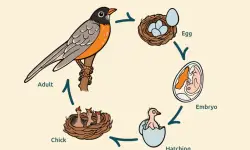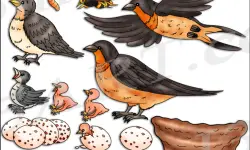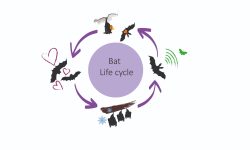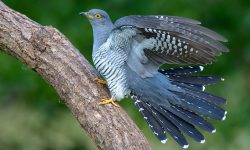Woodpeckers are one of the most fascinating bird species in North America, known for their drumming calls and unique behavior. With their strong beaks and specialized feeding techniques, these birds play an essential role in forest ecosystems by controlling insect populations and helping to break down dead trees. If you’re curious about the diverse world of woodpeckers, you’re in the right place. In this article, we will explore 23 types of woodpeckers in North America, each with its own distinct characteristics and habitat preferences.
From the massive Pileated Woodpecker to the small and agile Downy Woodpecker, the types of woodpeckers found across North America are as varied as the landscapes they inhabit. Whether you’re an avid birdwatcher or just beginning to learn about these remarkable creatures, understanding the differences between species can enhance your appreciation for their role in the natural world. Throughout this guide, we’ll introduce you to woodpeckers of all shapes and sizes, highlighting their unique traits and behaviors.
In addition to offering detailed descriptions of each species, this article will also provide pictures to help you identify the various types of woodpeckers you might encounter. From the forests of the Pacific Northwest to the deserts of the Southwest, North America is home to an incredible variety of woodpeckers. So, let’s dive into the world of woodpeckers and discover the beauty and diversity of these captivating birds.
Large Types of Woodpeckers – Genus Dryocopus
Pileated Woodpecker (Dryocopus pileatus)
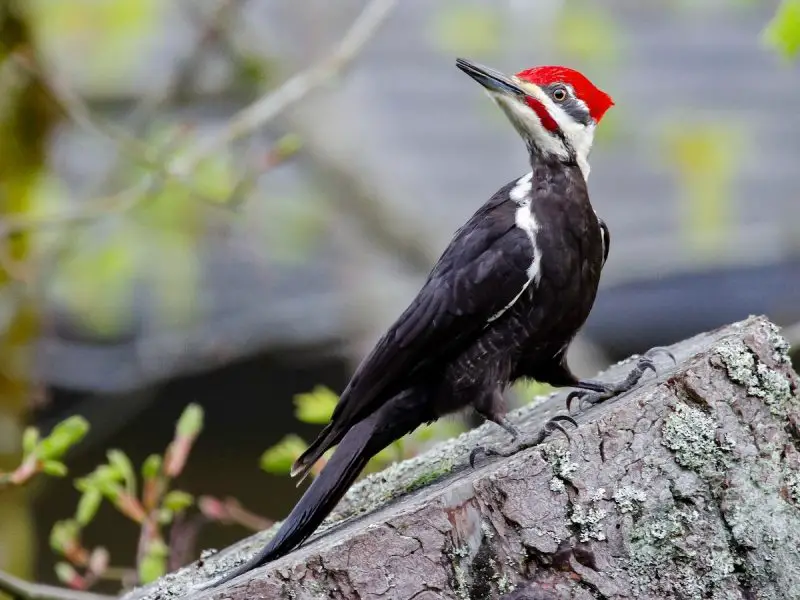
The Pileated Woodpecker is a striking bird, instantly recognizable by its large size and vibrant red crest. Measuring about 16 to 19 inches in length with a wingspan reaching up to 30 inches, it is roughly the size of a crow, making it the largest woodpecker commonly seen in North America. Its plumage is mostly black with white stripes on the neck and face, and when in flight, large white underwings become visible. Males have a red stripe on the cheek, while females have a black one, helping distinguish the sexes.
This iconic type of woodpecker is well known for its impressive chiseling ability, creating rectangular holes in trees in search of carpenter ants and wood-boring beetle larvae—its primary food sources. The loud, echoing drumming sounds and high-pitched “kuk-kuk-kuk” calls are also characteristic of this species. Its strong bill and reinforced skull structure allow it to excavate deep into hardwood trees, often leaving behind cavities later used by other birds and mammals.
Pileated Woodpeckers are found year-round in mature forests across Canada, the eastern United States, and parts of the Pacific Northwest. They prefer large tracts of deciduous or mixed woodlands with dead trees for nesting and foraging. Despite habitat loss in some areas, the species has adapted relatively well to fragmented forests and even suburban parks with suitable tree cover, making it a fascinating and relatively accessible bird for enthusiasts across much of its range.
Colorful and Social Types of Woodpeckers – Genus Melanerpes
Red-headed Woodpecker (Melanerpes erythrocephalus)
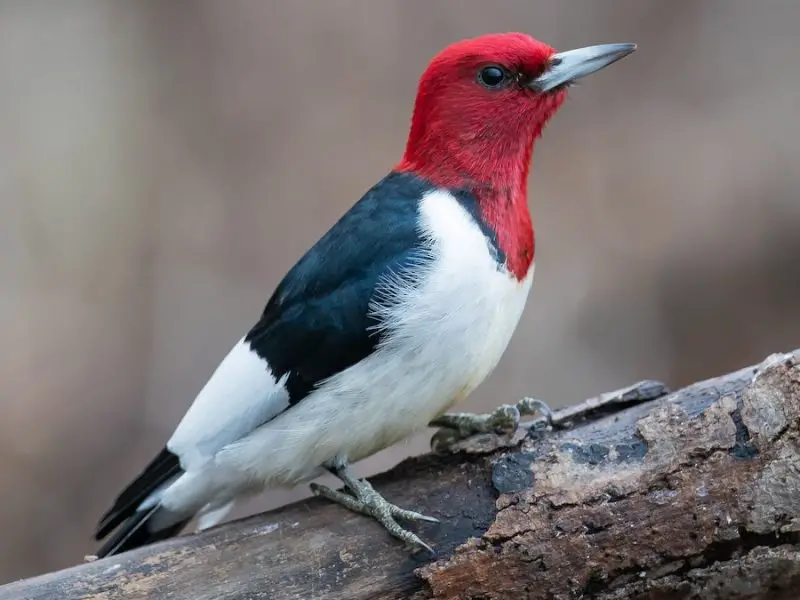
The Red-headed Woodpecker is a striking and easily identifiable bird, named for its entirely crimson head that contrasts vividly with its snowy white body and black wings. Adults display a clean, bold color pattern that is quite unlike most other woodpeckers. Juveniles, however, are duller and lack the red coloration, which they develop gradually as they mature.
This visually bold type of woodpecker is known for its varied diet and impressive aerial agility. It eats insects, fruits, seeds, and even small vertebrates, and is one of the few woodpeckers that stores food for later use—often wedging insects or nuts into bark crevices. Unlike many woodpeckers, it is frequently seen catching insects in midair, using quick and acrobatic maneuvers.
The Red-headed Woodpecker is found across the eastern and central United States, favoring open woodlands, pine savannas, orchards, and forest edges. Though its range is relatively broad, populations have declined due to habitat loss and changes in land use. Conservation efforts now focus on preserving the open forests and dead trees that are essential to this species’ survival.
Acorn Woodpecker (Melanerpes formicivorus)
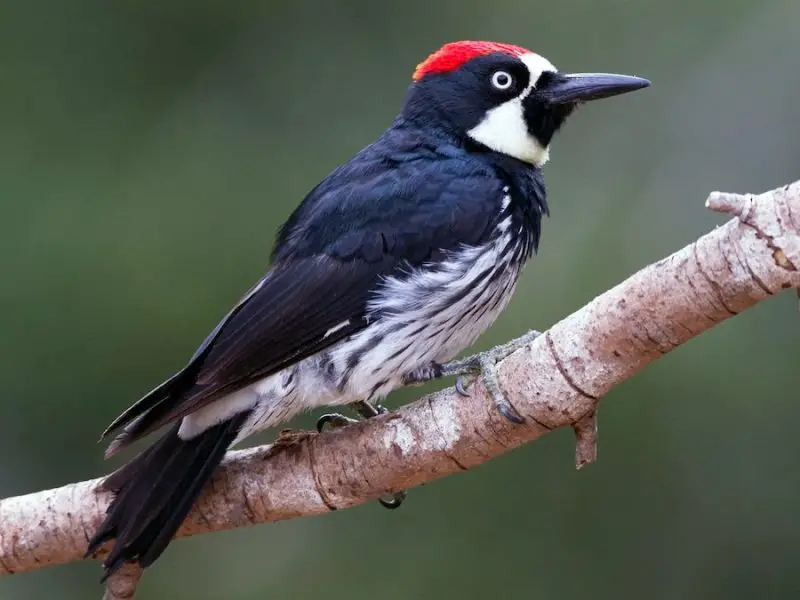
The Acorn Woodpecker is a colorful and eccentric species with a clown-like face: white forehead, black crown, red cap, and bold white eyes. Its back is glossy black, while the underparts are a mixture of white and black. Males and females look very similar, although males have slightly more extensive red on the head.
This fascinating type of woodpecker is best known for its cooperative social behavior and its habit of storing thousands of acorns in specially drilled holes, often on the same “granary” tree for generations. These storage trees can contain thousands of acorns, meticulously placed into drilled holes in bark or even telephone poles. Acorn Woodpeckers live in large family groups and engage in cooperative breeding, where multiple individuals help raise the young.
They are primarily found in oak and mixed forests of the western United States, especially California, as well as in parts of Central America. This species thrives in areas with a high density of oak trees, which provide both food and nesting cavities. Their complex social structure and resource-hoarding behavior make them one of the most unique woodpeckers in North America.
Lewis’s Woodpecker (Melanerpes lewis)
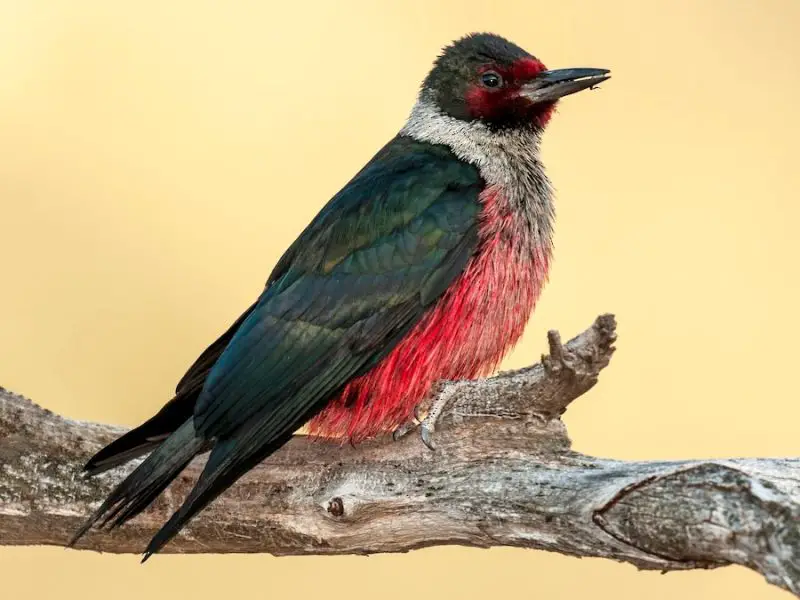
Lewis’s Woodpecker stands out among woodpeckers for its unusual coloration and behavior. Its plumage includes dark greenish-black on the back, a gray collar, a pinkish-red belly, and a reddish face—quite different from the typical black-and-white patterns of many woodpeckers. The bird was named after Meriwether Lewis of the Lewis and Clark expedition.
Unlike most types of woodpecker, Lewis’s Woodpecker often flies like a crow, with slow, graceful wingbeats, and spends a great deal of time catching insects in midair. It also eats fruits, nuts, and seeds, storing food for winter in bark crevices. Rather than drumming frequently on trees, it is relatively quiet and more likely to be seen than heard.
Lewis’s Woodpecker is found in open pine forests, burned woodlands, and oak savannas in the western United States and southern British Columbia. Its range is patchy and often changes depending on food availability, especially in winter. Due to habitat degradation and fire suppression, its population has seen a gradual decline, prompting conservation interest in protecting suitable foraging and nesting habitats.
Gila Woodpecker (Melanerpes uropygialis)

The Gila Woodpecker is a striking bird that thrives in the arid landscapes of the American Southwest. This species features a bold black-and-white striped back and a pale belly, with a distinctive red crown and nape. Males tend to have a brighter red patch on their heads, while females’ red markings are less pronounced. Their strong beaks are perfectly suited for drilling into the dry desert trees where they make their nests.
Known for its adaptability, the Gila Woodpecker is highly specialized for life in the desert. It primarily feeds on insects, fruits, and seeds, using its beak to create cavities in cacti, especially the saguaro, where it finds both food and shelter. Unlike many other woodpeckers, Gila Woodpeckers have been observed to nest in cacti, making use of their tough, spiny exteriors as both protection and a food source.
This woodpecker species is found in the desert regions of southern Arizona and parts of New Mexico, often in areas with cacti or mesquite trees. While its population is generally stable, urbanization and habitat loss in the Southwest have led to concerns about the future of this distinctive woodpecker.
Golden-fronted Woodpecker (Melanerpes aurifrons)
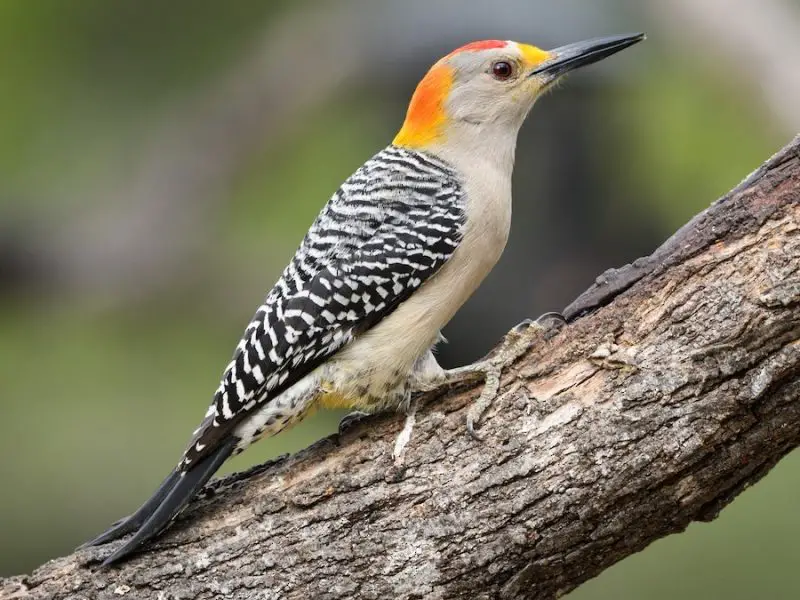
The Golden-fronted Woodpecker is a vibrant species with a striking appearance. It is easily identifiable by the bright golden-yellow coloration on its forehead, which contrasts beautifully with the white and black pattern on its wings and back. The species also has a red crown, with males displaying more red than females. The golden hue on its forehead, combined with its bold markings, makes this woodpecker one of the most colorful in its region.
This type of woodpecker is known for its versatility in feeding habits. It primarily feeds on insects found under the bark of trees, but it will also consume fruits, nuts, and seeds. The Golden-fronted Woodpecker is often seen foraging in the forests and woodlands of Texas, Mexico, and Central America. It is particularly fond of mesquite and oak trees, where it often drums in search of food.
The Golden-fronted Woodpecker is typically found in the southern United States, Mexico, and parts of Central America. This species favors open woodlands, semi-arid landscapes, and areas with an abundance of acorns and other food sources. Habitat loss due to deforestation is a concern, but the species continues to thrive in many areas.
Red-bellied Woodpecker (Melanerpes carolinus)
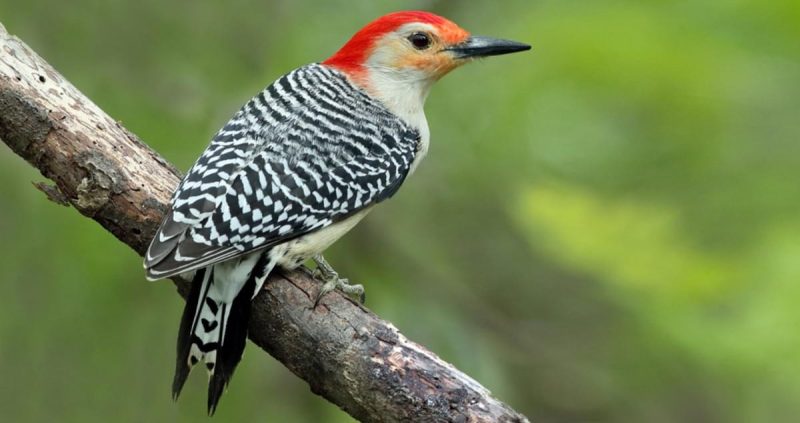
The Red-bellied Woodpecker is a medium-sized woodpecker with striking features. Its most notable characteristic is the red patch on its head and nape, with males having more extensive red than females. Its belly, as the name suggests, is lightly tinged with red, though the coloration is often more subtle than its vibrant head. The rest of its body is primarily white with black-and-white striped wings and back, making it easily recognizable in wooded habitats.
This woodpecker has a varied diet, consisting of insects, acorns, and other nuts. It is also known for its ability to store food in tree bark for later consumption. The Red-bellied Woodpecker is one of the few woodpeckers that will forage for food in a variety of habitats, including forests, suburban areas, and even city parks, where it has adapted to human presence.
The Red-bellied Woodpecker is commonly found in the eastern United States, from southern New England down to Florida and parts of Texas. It prefers mixed woodlands and forests but is also seen in suburban neighborhoods with mature trees. Despite some localized declines, the species remains widespread and is often seen at bird feeders, particularly in the winter months.
Sapsucker Types of Woodpeckers – Genus Sphyrapicus
Yellow-bellied Sapsucker (Sphyrapicus varius)
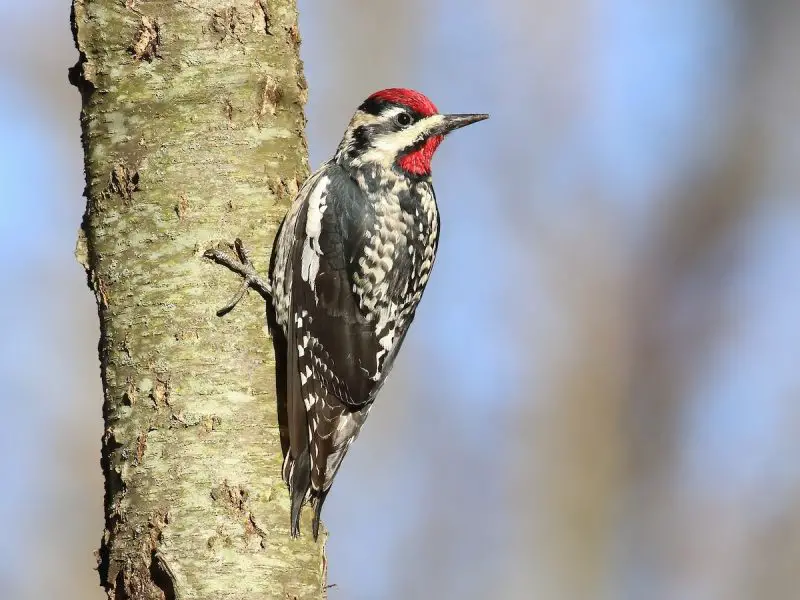
The Yellow-bellied Sapsucker is a striking and migratory species recognized for its unique behavior of drilling sap wells into trees. This woodpecker has a black-and-white striped back with a bold red crown and throat, while its belly is often pale with a subtle yellowish hue. Both males and females have similar markings, although males have slightly brighter red coloration on the throat and crown.
As the name suggests, the Yellow-bellied Sapsucker primarily feeds on tree sap, drilling small holes in the trunks of various deciduous trees to create sap wells. It also consumes insects and berries when available, and it has a particular fondness for birch, maple, and oak trees. This woodpecker’s ability to drill into trees is essential for both feeding and creating nesting sites.
The Yellow-bellied Sapsucker is found throughout the eastern and northern parts of North America during the breeding season, migrating to the southern United States and Central America for the winter. Its migration patterns and reliance on tree sap make it a distinctive species, though it is increasingly at risk from habitat loss and climate change.
Red-naped Sapsucker (Sphyrapicus nuchalis)
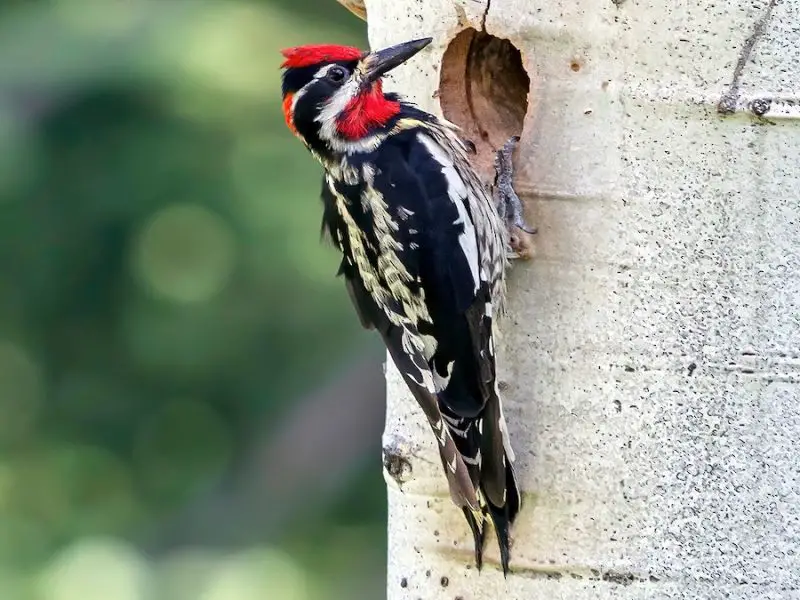
The Red-naped Sapsucker is a beautiful woodpecker found in the western United States. It features a black-and-white striped back, and its most striking feature is the red patch on the back of its neck, which distinguishes it from its eastern counterpart, the Yellow-bellied Sapsucker. It also has a bold red throat and a white belly, with males having slightly more pronounced red markings than females.
This woodpecker feeds on sap from a variety of trees, such as aspens, cottonwoods, and maples, drilling rows of small, neat holes into the trunks to create sap wells. In addition to sap, it consumes insects and berries, making it an adaptable forager. The Red-naped Sapsucker is often found in montane forests, where it drills into mature trees to extract sap and establish breeding territories.
The Red-naped Sapsucker is found throughout the western parts of North America, particularly in the Rocky Mountains and surrounding regions. It migrates seasonally, heading south for the winter, and is often seen in riparian woodlands during its migration. Despite its migratory nature, habitat destruction due to logging and urbanization poses a threat to its population.
Red-breasted Sapsucker (Sphyrapicus ruber)
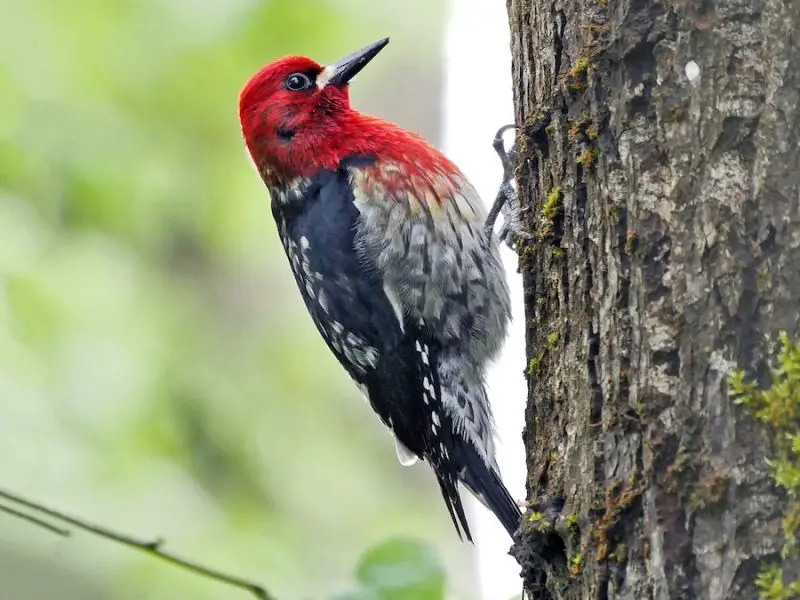
The Red-breasted Sapsucker is a colorful woodpecker with striking red and white plumage, commonly found along the Pacific Coast. Its most notable feature is the brilliant red on its throat and chest, contrasting with its white belly and black-and-white striped back. The species shows dimorphism, with males exhibiting more intense red coloration compared to females.
This woodpecker specializes in tapping trees for sap, particularly favoring conifers like pine and fir trees. In addition to sap, it also consumes insects, especially during the breeding season. The Red-breasted Sapsucker is skilled at drilling precise holes in tree trunks, creating sap wells that provide a consistent food source. It can be seen working through large swaths of forested areas, often returning to the same trees day after day.
The Red-breasted Sapsucker is found primarily in coastal forests of the Pacific Northwest, ranging from southern Alaska to northern California. Unlike other sapsuckers, this species is more likely to remain in its habitat year-round, though it does shift its range slightly depending on food availability. Logging and habitat loss continue to impact its population in some areas.
Williamson’s Sapsucker (Sphyrapicus thyroideus)
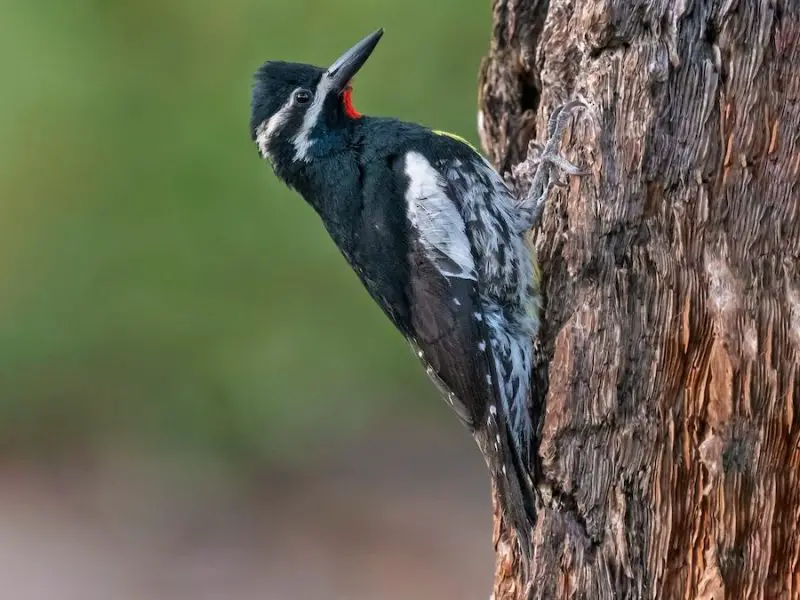
Williamson’s Sapsucker is a strikingly beautiful and distinctive species, easily recognized by the marked difference between males and females. Males feature a bold red chest and throat, while females are primarily black and white with no red on the chest. This sexual dimorphism is one of the key features that sets this species apart from other woodpeckers.
This type of woodpecker feeds primarily on sap, drilling holes in coniferous trees such as pines and firs to create sap wells. In addition to sap, it also feeds on insects and fruits. It is known for its territorial behavior, with males often defending specific trees or areas that provide the necessary food resources. Its distinctive drumming and feeding behavior are also key traits of this species.
Williamson’s Sapsucker is found in the high-altitude forests of the western United States, particularly in mountainous regions like the Rockies and the Sierra Nevada. It is a migratory species, with some individuals moving to lower elevations or more temperate areas in winter. Habitat destruction, particularly in higher altitudes, poses a threat to its population, although it continues to thrive in suitable forests.
Ground-Feeding Types of Woodpeckers – Genus Colaptes
Northern Flicker (Colaptes auratus)
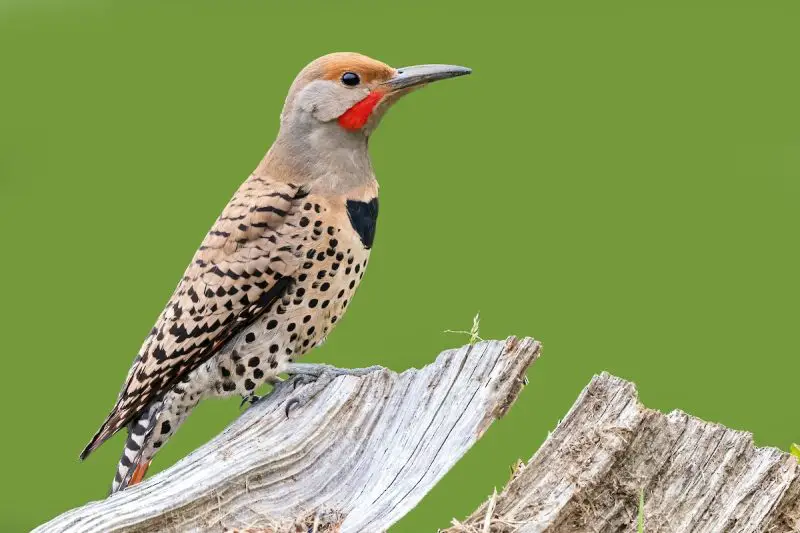
The Northern Flicker is a large and widely distributed woodpecker species, easily recognized by its unique foraging behavior and striking plumage. Unlike many woodpeckers, the Northern Flicker often forages on the ground, using its long bill to probe for ants, beetles, and other insects in the soil. Its plumage is a mix of browns and yellows, with black spots on its chest and a distinctive crescent-shaped marking on its back. Males are identified by a black “moustache” marking on the sides of their faces.
Northern Flickers are primarily insectivores, and their diet is largely composed of ants and beetles, which they uncover by foraging on the ground or in tree bark. They will also eat fruits and seeds when other food sources are scarce. They are known for their loud, repetitive drumming on tree trunks, which they use to establish territory and attract mates. The Northern Flicker is one of the few woodpeckers that will nest in both trees and man-made structures, including utility poles and fence posts.
This woodpecker is found across North America, from Canada to the southern United States, and it is a common sight in woodlands, forests, parks, and even suburban areas. It is migratory in some parts of its range, particularly in the northern regions, where it moves south for the winter. The species is relatively adaptable, thriving in a variety of habitats, but urbanization and loss of mature trees are ongoing concerns.
Gilded Flicker (Colaptes chrysoides)
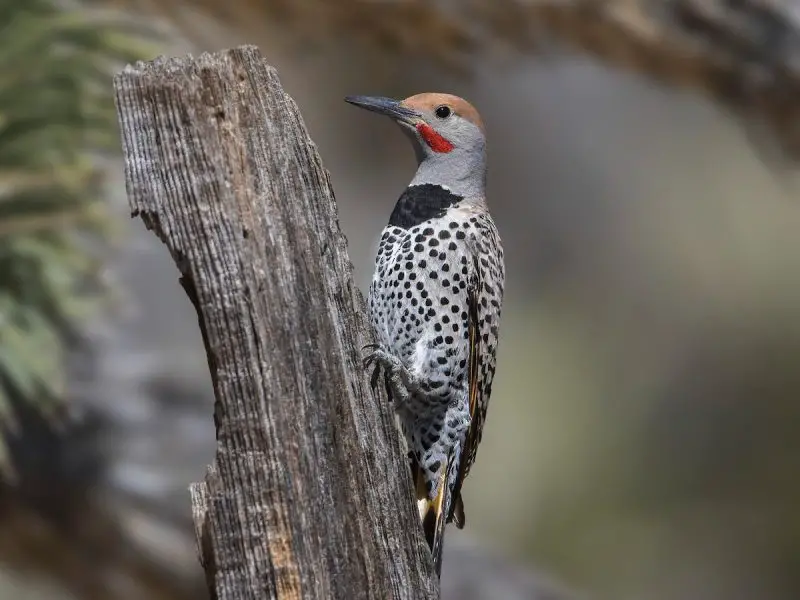
The Gilded Flicker is a unique and striking woodpecker species native to the desert regions of the American Southwest. This flicker has a distinctive appearance, with a golden or yellowish cast to its plumage, which sets it apart from other woodpeckers. Its back is covered in brown and black spots, and it has a reddish-brown patch on its nape. Males also have a characteristic red “moustache” marking. The Gilded Flicker is similar in size to the Northern Flicker but has adapted to life in harsh desert environments.
This woodpecker species has specialized feeding habits, primarily drilling into cactus plants, including the saguaro, to feed on insects and sap. Its diet also includes ants and beetles, which it often finds in the bark of desert trees. The Gilded Flicker uses its strong beak to create nesting cavities in cactus or mesquite trees, and it is highly adapted to the arid conditions of the Sonoran Desert. Its drumming and calls are distinctive and can be heard echoing through the desert landscape.
The Gilded Flicker is found in the southwestern United States, particularly in Arizona and parts of California, as well as in Mexico. It inhabits desert areas with plenty of cactus, mesquite, and other desert trees. Due to its reliance on specific habitats, the Gilded Flicker faces challenges from habitat degradation and water scarcity, but it continues to thrive in areas where desert ecosystems remain intact.
Small and Tree-Clinging Types of Woodpeckers – Genus Picoides
Downy Woodpecker (Picoides pubescens)
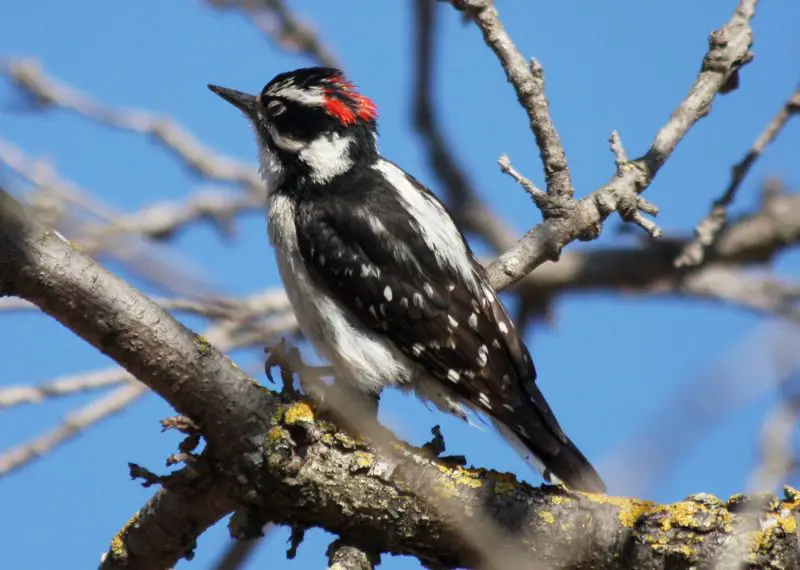
The Downy Woodpecker is the smallest woodpecker species in North America, measuring just 6 to 7 inches in length. This tiny woodpecker has a black-and-white patterned back, with a white underbelly and distinctive black wings with white spots. The male Downy has a small red patch on the back of its head, which distinguishes it from the female. Despite its small size, the Downy Woodpecker is highly active and is often seen hopping up and down tree trunks in search of insects.
Downy Woodpeckers primarily feed on insects such as ants, beetles, and caterpillars, as well as the occasional fruit or berry. They use their strong beaks to drum on trees, creating holes to access insects hiding in the bark. While they are often seen in deciduous forests, they also thrive in urban and suburban areas, where they frequently forage in parks and gardens. They are known for their ability to forage both in the bark and on twigs and branches, making them highly adaptable.
This species is found across North America, from southern Canada to northern Mexico. It is common in forests, woodlands, and even suburban yards, where it can often be seen at bird feeders. The Downy Woodpecker is non-migratory and tends to remain in its home range year-round, although it may shift to different areas during the winter depending on food availability.
Hairy Woodpecker (Picoides villosus)
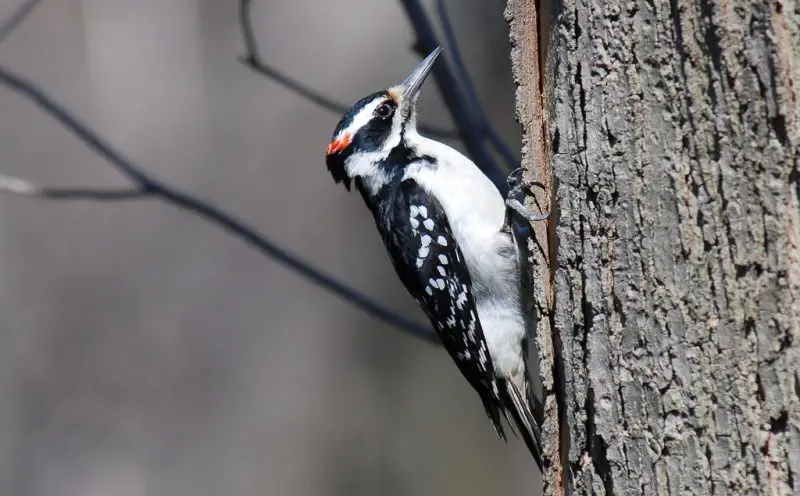
The Hairy Woodpecker is a larger counterpart to the Downy Woodpecker, measuring 9 to 10 inches in length. Despite their similar appearance, the Hairy Woodpecker is significantly larger, with a more robust body and longer bill. Like the Downy, the Hairy Woodpecker has a black-and-white patterned back and a white underbelly. The male Hairy Woodpecker has a red patch on the back of its head, similar to the Downy, but the overall size difference makes the Hairy Woodpecker easier to identify at a glance.
Hairy Woodpeckers feed primarily on insects that they find under the bark of trees, particularly ants, beetles, and wood-boring larvae. They are also known to visit suet feeders in areas where they coexist with humans. Their drumming on tree trunks is one of their most noticeable behaviors, and they will often drum loudly to establish territory. Hairy Woodpeckers prefer mature forests, where they can find the insects they depend on, and they tend to nest in old, decaying trees or snags.
This species is found throughout North America, from southern Canada to northern Mexico. It inhabits forests, particularly those with abundant deciduous trees, and is generally a non-migratory bird. Hairy Woodpeckers are year-round residents in most parts of their range, although some populations may shift locations in response to seasonal food availability.
Ladder-backed Woodpecker (Picoides scalaris)
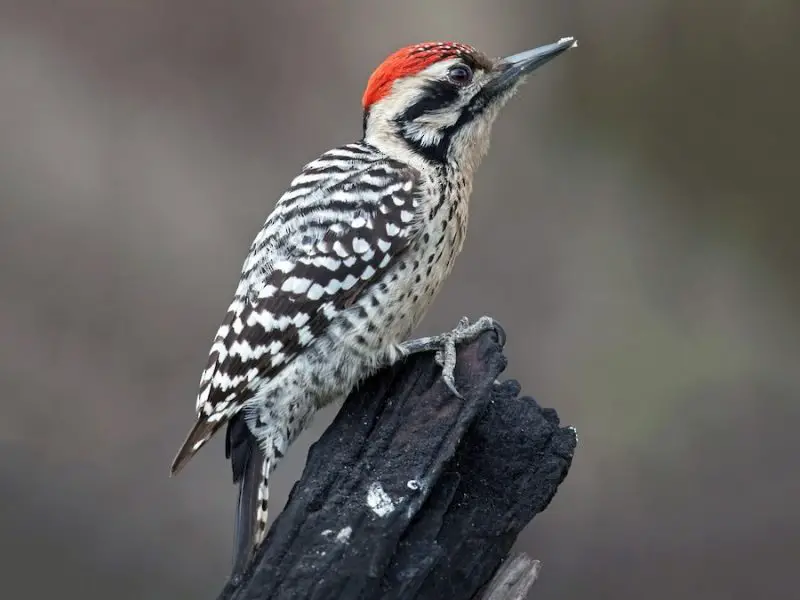
The Ladder-backed Woodpecker is a striking species adapted to life in the arid desert landscapes of the southwestern United States and Mexico. This small woodpecker has a bold, striped pattern on its back, resembling a ladder, which is where it gets its name. The black-and-white stripes extend down the back, while the bird’s head is adorned with a red crown and nape. Males have a more vibrant red patch on the back of their heads, while females lack this feature.
The Ladder-backed Woodpecker is a versatile forager that feeds on a variety of insects, including ants, beetles, and termites, which it uncovers by pecking at trees, cacti, and even yucca plants. This species is known to drum on trees to establish territory, and it also creates cavities in the trunks of trees for nesting. It thrives in desert environments, where it is often found in mesquite, creosote bush, and cactus forests. Its ability to adapt to the desert environment has allowed it to become a common and resilient species.
This woodpecker is native to the southwestern United States, particularly in Arizona, New Mexico, and parts of California, as well as in northern Mexico. It is typically found in desert scrublands, open woodlands, and riparian areas. The Ladder-backed Woodpecker is largely non-migratory and remains in its desert habitat year-round.
Nuttall’s Woodpecker (Picoides nuttallii)
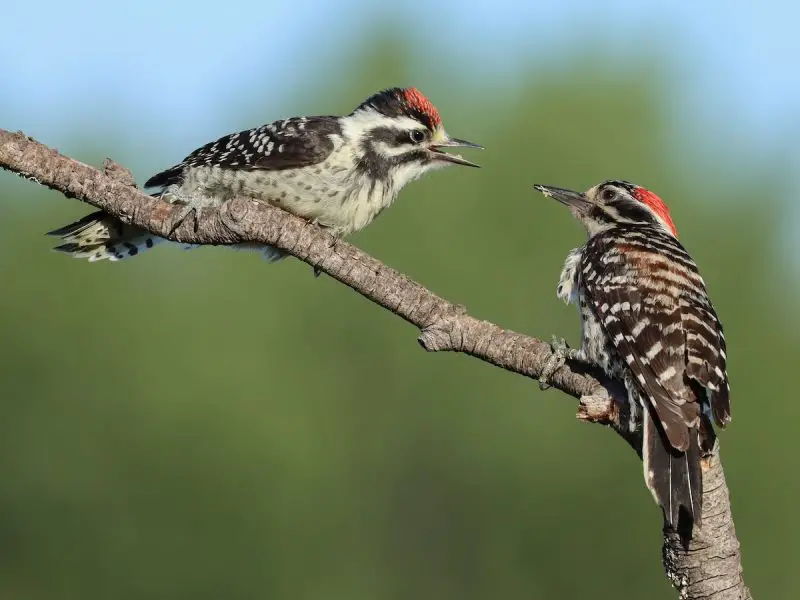
Nuttall’s Woodpecker is a small, attractive species found only in California. It is similar in appearance to the Downy Woodpecker, but it has a more distinct black-and-white striped back and a slightly more vibrant red patch on its head. Males have a red nape, while females do not. Nuttall’s Woodpecker is often seen in oak woodlands, where it taps on the trunks of trees to forage for insects, particularly beetles and ants. Its distinctive drumming can be heard echoing through the forests, signaling the presence of this active woodpecker.
This species feeds primarily on insects that it uncovers under the bark of trees, and it is often observed in oak forests, riparian woodlands, and even suburban areas with mature trees. Nuttall’s Woodpecker is an adept forager, able to search both the trunks of trees and the smaller branches for food. The woodpecker also uses its strong beak to excavate nesting cavities, which it places in mature oak trees.
Endemic to California, Nuttall’s Woodpecker is found primarily in the central and northern regions of the state. It is typically non-migratory, though its range can shift slightly depending on food availability and habitat changes. This woodpecker is relatively common in suitable habitats but is affected by habitat loss due to urban development.
Arizona Woodpecker (Picoides arizonae)
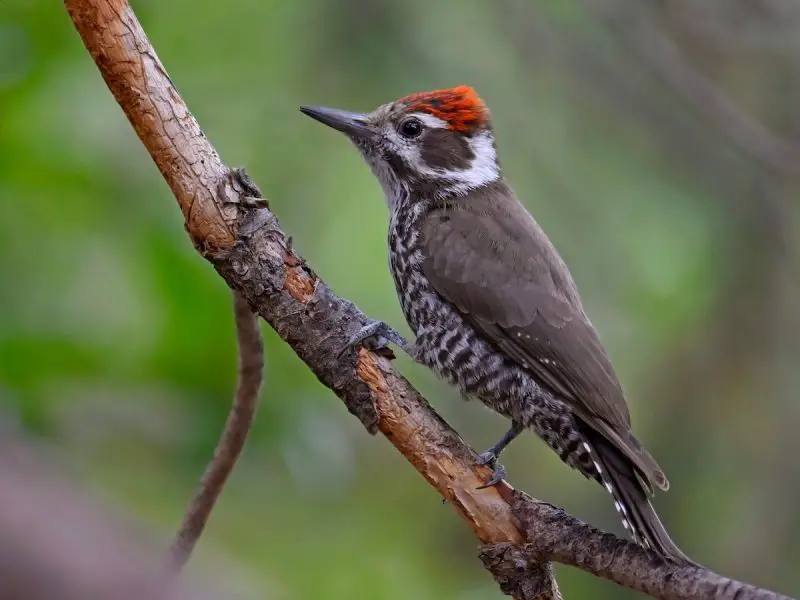
The Arizona Woodpecker is a striking and somewhat elusive species found in the forests of the southwestern United States. It has a unique appearance, with a brown and white striped back and a distinctive red patch on the back of its head. Males have a more pronounced red area on their nape, while females have a smaller, more muted red patch. This woodpecker’s plumage is more subdued compared to other woodpecker species, but its distinctive markings make it easy to identify when spotted.
Arizona Woodpeckers primarily feed on insects, including ants, beetles, and wood-boring larvae, which they extract from tree trunks and branches. They are particularly fond of pine and oak trees, where they create sap wells and nest cavities. Their drumming on trees is a distinctive behavior used to establish territory, and they often forage in small groups or pairs. The Arizona Woodpecker is highly adapted to the dry, mountainous regions of the Southwest, where it thrives in oak and pine forests.
This woodpecker is found in the mountainous regions of Arizona, New Mexico, and northern Mexico, where it is often seen in dense forests and woodlands. It is a non-migratory species, remaining in its home range throughout the year. However, the Arizona Woodpecker’s population is affected by habitat destruction and climate change, which threaten the availability of suitable forests.
Endangered Types of Woodpeckers – Genus Dryobates
Red-cockaded Woodpecker (Dryobates borealis)
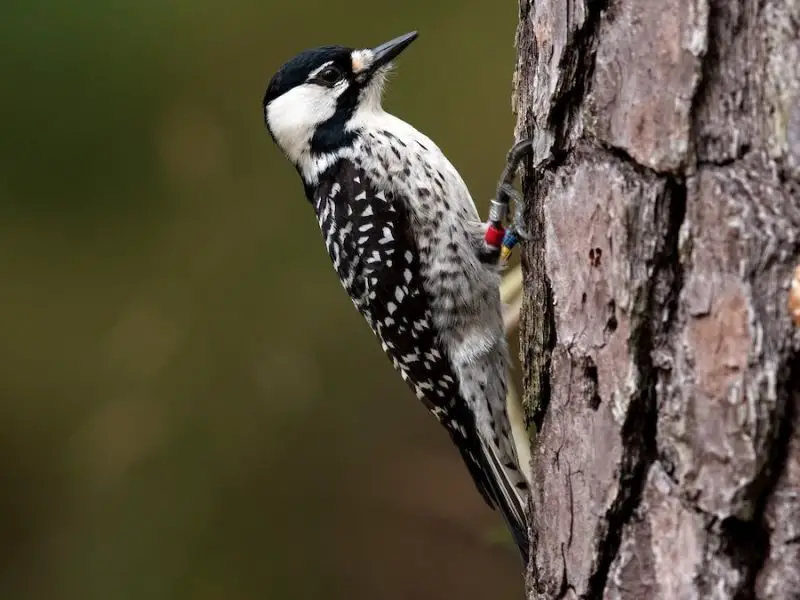
The Red-cockaded Woodpecker is a rare and highly specialized species of woodpecker found in the southeastern United States. Unlike most woodpeckers, this bird relies on mature pine forests with a specific structure for its habitat. The Red-cockaded Woodpecker is easily identified by its black-and-white plumage and the small, red “cockade” or patch of feathers located on the sides of its head, which is visible primarily in males. Its body is relatively small, measuring around 8 to 9 inches in length, and it has a distinctive, high-pitched drumming call.
This species is known for its unique behavior of creating cavities in living pine trees, specifically longleaf pine and slash pine, which are often over 60 years old. The cavities are excavated in the heartwood of the tree, making them resistant to decay. Red-cockaded Woodpeckers are insectivorous and primarily feed on ants, beetles, and other insects found under the bark of these pines. They also rely on the pine forest ecosystem for nesting and roosting, where they live in small family groups, often with multiple generations in the same cavity tree.
Due to its highly specific habitat needs, the Red-cockaded Woodpecker has become endangered, with its population severely reduced over the years. This woodpecker is found primarily in the southeastern U.S., including parts of North Carolina, Florida, Alabama, and Georgia, within pine forests that have been affected by logging and fire suppression. Conservation efforts are focused on restoring and protecting the longleaf pine habitat, which is essential for the species’ survival. Unfortunately, these efforts have not yet led to a complete recovery, making the Red-cockaded Woodpecker one of the rarest woodpeckers in North America.
Legendary Types of Woodpeckers – Genus Campephilus
Ivory-billed Woodpecker (Campephilus principalis)
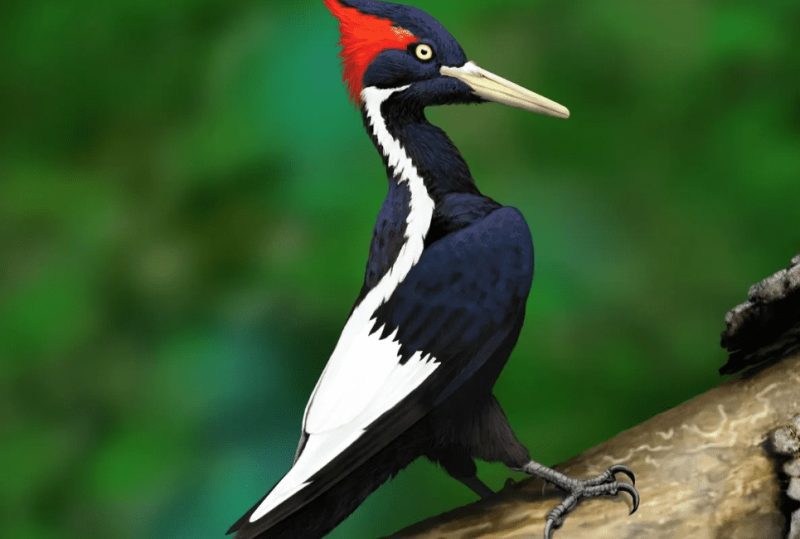
The Ivory-billed Woodpecker is one of the most legendary and elusive birds in ornithology, often referred to as the “Lord God Bird” due to its striking appearance and size. This large woodpecker was primarily found in the bottomland hardwood swamps of the southeastern United States, particularly in the vast forests of the Mississippi River Valley and parts of Florida. It was recognized for its large size, measuring around 19 to 20 inches in length, and its striking black and white plumage, with a prominent ivory-colored bill that gave it its name. The male had a distinctive red crest, making it easy to distinguish from the female.
This woodpecker fed mainly on wood-boring beetles, particularly the larvae of the longhorn beetles, which it found by pecking at the trunks of large, dead or decaying trees. The Ivory-billed Woodpecker was a skilled forager, known for its loud, rapid drumming on tree trunks. It was also known to create large cavities in the trees, where it would nest and roost. The bird was associated with old-growth forests that were rich in biodiversity, providing both food and nesting sites in mature hardwood trees.
Despite numerous reported sightings over the years, the Ivory-billed Woodpecker is widely considered to be functionally extinct, with the last confirmed sighting occurring in the 1940s. However, there have been occasional reports of sightings in remote areas, particularly in parts of Arkansas and Louisiana, leading some to speculate that small populations may still exist. The destruction of its natural habitat, particularly due to logging and land development, is largely blamed for the species’ decline. Efforts to locate and protect the Ivory-billed Woodpecker continue, but its status remains uncertain, and it serves as a tragic reminder of the impacts of habitat loss on species that require specialized environments to survive.

